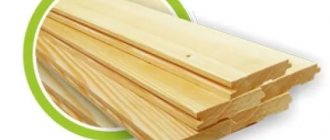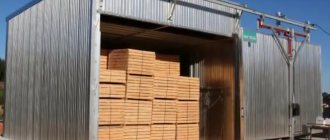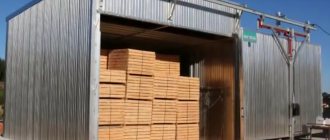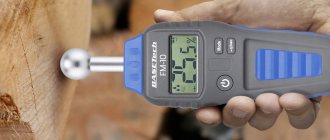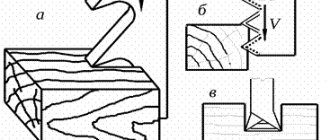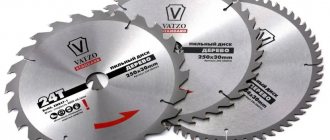Drying lumber is an important stage in preparing lumber for work, as a result of which excess moisture is released from the timber through evaporation. Why do this? Dry lumber is highly durable. They warp much less, stick together easily, and do not rot or crack. The resulting materials can be easily decorated and are characterized by high reliability. It turns out that the wood drying procedure is mandatory if you want to obtain materials of ideal quality.
Why is wood drying necessary?
After a tree trunk is cut down, the wood has a fairly high percentage of moisture content. However, during operation this level gradually decreases. If you use such raw materials in construction or manufacturing parts, you will not be able to avoid cracks and manufacturing defects. After all, drying will occur uncontrollably, under the influence of chaotic phenomena in the form of high temperatures, surges in air humidity and precipitation.
Therefore, the entire wood drying process must be strictly controlled or, at a minimum, the most suitable conditions for this must be created. It is possible to use various methods that may require a longer period to dry the rock (up to several years) and may be quick (less than a day). Also, when drying lumber, special devices, installations and equipped technical rooms are often required. In modern production, several methods are actively used, each of which has certain advantages and disadvantages.
Type of heating
Today, a fairly common phenomenon is the desire of most owners of drying kilns and those who are just planning to purchase one to establish heat supply from a hot water boiler that runs on sawmill and woodworking waste. At the same time, many have little idea about the required amount of waste and consider this option to be the cheapest. Maybe in the case of high-power boiler houses of 1-2 MW or more, this is true. Moreover, such boilers are also considered as a wood waste recycler at their enterprise.
In fact, when organizing a small boiler room for autonomous heat supply to the drying chamber, it is more economical to use electric heating or water heating boilers running on gas, diesel fuel and coal. The automatic burner of gas boilers does not require the presence of an operator. In regions with low electricity costs, electric boiler systems are naturally common. Automation of the drying and heat supply process affects the cost reduction, therefore, in the end, it turns out cheaper, or at least is at the level of heating the chamber with woodworking waste.
Wood drying methods
As mentioned above, fast or slow drying of lumber can be used. Depending on the availability of technical or financial means, it is possible to use chamber, natural, rotational, infrared, vacuum or liquid drying. It is best to consider the options separately to more clearly identify the pros and cons of each method.
Kiln drying
The chamber drying method is the most common and popular due to its clear control of the result, low percentage of defects, and short time to obtain the finished product. However, the cost of chamber-dried lumber is sometimes higher, since the costs of such installations and their startup must be included in the final cost of the material.
Drying chambers for wood differ in the design of the equipment inside, as well as the permissible loading volume. Boilers that are designed to supply heat can produce either smokeless steam or flue gases, depending on the type. In the first case, the initial temperature can exceed 1000 degrees, which, of course, is an unacceptably high indicator. Therefore, to reduce it, it is necessary to provide a pipe system that will facilitate the process of cooling the steam to 40-80 degrees. The temperature of the flue gases is most suitable for getting rid of moisture in lumber, so such measures are not required.
The methods of organizing the circulation of air masses also differ, which affects the speed of the drying process of lumber. There are chambers with natural ventilation, which are less efficient than types with a clearly organized and thought-out heat exchange process. Among the latter, the most expensive to maintain is the convection chamber for wood. However, a well-thought-out system of technological fans allows us to quickly obtain even heat-resistant types of lumber, which are used in decoration and some types of construction.
Preparation of lumber in drying chambers has the advantage of being able to regulate the degree of humidity of the finished product. Depending on the customer’s requirements, the indicator can vary from 6 to 18 degrees with a stable average value over the entire thickness and length. Such chamber drying technologies also make it possible to timely regulate the drying intensity, which reduces the level of defects, the number of cracks and the degree of deformation. Processing wood and lumber in drying chambers ensures stable results and minimal loss of quality.
Natural drying
The longest and most cost-effective method is natural drying. The organization will require a minimum amount of material resources - flooring and shelter for lumber, as well as a place for their long-term maintenance (several years).
The method is most often used in private households, when there is a utility room (shed, garage) and the volume of workpiece is small. An undoubted advantage is the absence of defects when installed correctly and maximum adaptability to adverse external factors.
Rotational method
The method combines chamber and infrared drying of lumber. The permissible number of workpieces in the form of boards, logs or saw cuts are placed in a closed chamber, where the drying process is organized using a ventilation system. Infrared radiation is used as a heat source, which penetrates deep layers in a minimum amount of time, which allows you to quickly dry lumber without causing internal stress. This allows you to reduce the number of cracks to less than 5%, and also carry out the process in record time - up to 20 hours per batch.
Conductive method
The method involves drying thin lumber in which damage is unacceptable. The essence is to compress the rock using plates heated to a certain temperature.
To remove condensation, fans are not required, but the installation of thermometers and sensors is required to regulate the degree of humidity inside the wood.
Atmospheric method
What distinguishes the method from the natural method is that the process lasts less time (from 1 season to a year). It is planned to place a small volume of lumber in the utility room, which is arranged in rows with gaps for ventilation. If temperature and ventilation allow, the humidity level inside the rock can reach 14-46%. Atmospheric drying is beneficial due to the low cost of organizing the process, and the advantage is that there is no need to purchase expensive equipment.
Infrared drying
The fastest method, which is based on a deep and short-term effect on all layers of lumber. Infrared waves act on moisture, squeezing it to the surface. As a result, there is no deformation and no cracks. For small volumes, it is possible to use household microwave cookers as equipment, while in industry analogues of higher power are used.
Vacuum drying
The method involves the use of special equipment that removes both internal and external moisture.
In addition, a vacuum dryer allows you to get rid of resin, but its high cost does not make the method popular.
Liquid drying
It is an effective pre-treatment method that partially removes internal moisture. To do this, lumber is dipped into a solution of salts or a special composition, and then boiled for a period of time, which is determined by the type of wood.
"A C"
The current state of drying equipment at Russian enterprises can only be described as satisfactory. Sawmills and woodworking industries that have been operating for a long time use a large number of drying chambers of old designs that require significant modernization. And in some cases, cameras are only listed on the balance sheet, but do not work.
In order to properly dry lumber in such conditions, production workers spend enormous amounts of energy and labor. It turns out to be a kind of vicious circle. It is not possible to invest in the re-equipment of drying equipment due to the lack of necessary financial resources. As a result, the company does not have enough resources for effective growth.
Rules for drying wood
Depending on the raw material, there are drying rules for different types of wood, as well as requirements for the quality of the resulting lumber. However, regardless of the type of wood, when making cuts it is necessary to take into account allowances for shrinkage, which are determined by the specifics of the selected material. The amount of lumber shrinkage in thickness and width depends on many factors:
- initial moisture content of wood;
- wood type;
- lumber thickness;
- chosen method.
The lumber shrinkage table shows acceptable limits taking into account the listed indicators. For example, GOST standards for shrinkage of coniferous species are lower than for less resinous species.
Wood drying technology, regardless of the chosen method, involves several important stages, on which, among other things, the amount of drying depends. For example, during the cooling process after the end of thermal exposure, it is important to maintain the required normalization temperature. Otherwise, deformation may even occur that was not observed before.
Processing of lumber and its further use is possible only after passing through all the necessary stages of drying. Ignoring this process will lead to deformation of buildings, drying out, and the appearance of rot and mold in logs and boards already used for construction.
Vector for deep processing
The fact that today wood processors are trying in one way or another to organize drying production at their enterprises indicates a desire to engage in deep wood processing, which brings great profit.
An increase in duties on the removal of round timber will lead to an even greater increase in the volume of deep wood processing in Russia. The development of the industry will inevitably affect a significant increase in drying capacity. The prospect for the development of wood drying in Russia as one of the fundamental stages in the production of high-quality wood products, which are used in many industries.
Buy or restore?
Again, returning to the topic of modernization, it should be noted that there is not always a need to buy a new drying chamber, demolish the old one and build a new one. If the condition of the drying chamber enclosing structures is in satisfactory condition, then reconstruction or equipping the dryer with modern equipment is a good option. Of course, if serious restoration is required, then the cost of reconstruction may be the same amount as the construction of a new drying chamber, then reconstruction is not advisable.
Often the need for reconstruction is dictated not only by the wear and tear of equipment or the destruction of fences, but by the task of reducing energy costs and improving the quality of drying or increasing the productivity of the dryer.
Preparation of material
The quality of drying largely depends on how correctly the stacks were prepared - the so-called packages of lumber, which are specially formed to be placed in the chamber. For example, uneven drying and deformation of individual areas on the boards will be the result of improper packaging.
There are usually two methods of this kind of preparation:
- single stack;
- batch formation of bookmarks.
In the first case, one stack includes several boards folded in the same configuration. Batch stacking assumes that the lumber will be stacked in several ready-made stacks. A rigid platform with a flat surface is used as the basis for the stack. It can be a rail trolley formed by separate tracks.
In order for chamber drying of wood to be carried out without leakage of the thermal agent, underloading of the stack is not allowed. It must be completely filled either with boards of the same length, or with lumber of different sizes staggered. One or more layers of lining are provided between the boards being joined.
Video on how to dry wood in the microwave
Anyone who often works with wood gradually gains experience. Craftsmen can guess what kind of reaction to expect from which type of wood, how exactly which type is deformed, and make the appropriate allowance. If you leave a processed raw piece on the table, it may burst.
During breaks in work (for example, when carving) or before drying in the microwave, it is necessary to put the product in a plastic bag.
Microwave: drying at home
Before starting the procedure, the workpiece is weighed and the weight is recorded. The item, wrapped in a plastic bag with holes made, is placed in the middle of the oven, and the minimum power is set. Processing time depends on the size of the item. Then the workpiece is cooled directly in the bag and warmed up again. The condensate from the bag is drained and the item is weighed.
The entire cycle is repeated several times until the mass becomes constant and stops decreasing.
If the item cracks in the first attempt, it is necessary to either reduce the power further or seal the ends of the workpiece. The mouthguards are wrapped in newspapers before being placed in the bag. You can also do this with other workpieces: this will reduce the likelihood of wood cracking.
After cooling, before the next cycle, the newspapers are replaced with new ones. If there are resin pockets in the array, the latter can boil, break it, and stain the oven with resin. Wrapping in paper will also help here.
If you continue the process of heating already dried wood, it can char and even catch fire.
Main stage
After the initial warm-up, drying immediately follows. But the transition must be gradual, which is reflected in the slow opening of the air exchange dampers that remove moisture. At the same interval, the optimal parameters of heat flows are established. The temperature regime, in turn, is regulated by the opening level of the chamber blinds. If it is necessary to increase the saturation of the agent, the inlet pipes are completely closed.
Also, the degree of saturation of the thermal effect can be adjusted by starting the steam generator. However, steam injection systems cannot be connected when the hood is open. During the operation, chamber drying of wood is controlled by temperature characteristics and its error. In production, information about these values is usually entered into a log every hour.
Are imported ones better?
I cannot agree with the opinion that the prospect for the development of wood drying in Russia lies only in the acquisition of imported drying chambers. The existing stereotype that imported dryers, although much more expensive in cost, allow drying to be of higher quality than domestic ones, is far-fetched and does not have strong and unambiguous evidence. Often, in confirmation of this, not the best example is given with the domestic and foreign automobile industry. Then the question arises: is it even possible to dry qualitatively not in imported dryers? In my opinion, it is possible to dry, if not better, then at exactly the same quality level, in domestic drying chambers.
The main advantages of imported drying chambers are their housing, consisting of aluminum panels, as well as automatic control systems that ensure high-quality drying.
However, the body of the drying chamber made of aluminum can be manufactured with high quality by most domestic enterprises. In addition, Russian manufacturers also complete their designs with imported components (fans, heat exchangers, control systems, etc.). I am confident that domestic companies are quite capable of developing and manufacturing new competitive designs of drying chambers.
In practice, when using imported chambers, problems arise, most often associated with the operation of the automatic drying process system. In most cases, lumber is dried according to factory programs installed in the control unit, and therefore completely rely on automation. Even with a minor malfunction in its operation, personnel are lost, and not everyone knows how to adequately control the camera in manual mode.
